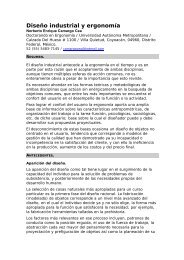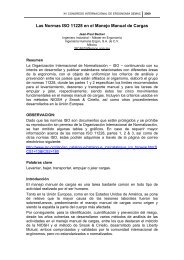ERGONOMÍA OCUPACIONAL - SOCIEDAD DE ERGONOMISTAS ...
ERGONOMÍA OCUPACIONAL - SOCIEDAD DE ERGONOMISTAS ...
ERGONOMÍA OCUPACIONAL - SOCIEDAD DE ERGONOMISTAS ...
Create successful ePaper yourself
Turn your PDF publications into a flip-book with our unique Google optimized e-Paper software.
Ergonomía Ocupacional. Investigaciones y Aplicaciones. Vol 3 2010<br />
The environmental experience as part of the learning process is student-way reference in its<br />
professional life. Hence the need to reorient educational objectives in design.<br />
Exercise 1: Acoustic study of a learning environment.<br />
1.1. INTRODUCTION. Conceptual Framework.<br />
As part of the exercise was revised conceptual framework based on Mapfre Foundation<br />
Ergonomics Handbook<br />
Ergonomics deals with the study of any physical environment from three sources: the<br />
measurable factors of the environment that are susceptible to modification, the physiological<br />
effects produced by these factors and also how the employee feels that environment. The sound<br />
from the physical point of view is a mechanical vibration transmitted through the air, capable of<br />
being perceived by the auditory organ.<br />
1.1.1. Sound effects in people.<br />
The sound effects can occur in people from three aspects: perception, extra-auditory effects,<br />
auditory effects.<br />
Perception.<br />
The inner ear acts as a transducer, transforming the physical signal (mechanical) in<br />
physiological signal (nervous), which is transmitted through the auditory nerve to auditory cortex,<br />
which produces the integration and interpretation of those signals.<br />
Extra-auditory effects.<br />
The fact that noise can cause physiological reactions of "stress" seems widely accepted, but has<br />
Sociedad de Ergonomistas de México, A.C. 88




